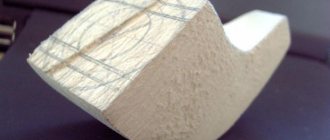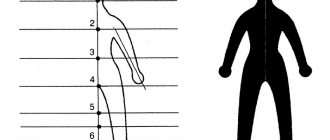Manual for relay games “Always 36.6”
Yulia Butova
A manual for relay games “Always 36.6” I bring to your attention
a manual for relay games - a thermometer.
Making a thermometer does not require much effort - you need thick cardboard, gouache and varnish (colorless, which can be replaced with tape).
1. We make a stencil of the desired size and shape and transfer it to cardboard.
2. Cut out the required number of thermometers (I have them-
.
3. We paint the thermometers on both sides with gouache.
4. After the paint has dried, coat the thermometers with varnish, preferably in two layers; you can carefully glue them with tape.
Options for games with thermometers:
Relay race for girls “Nurses”
Girls of the senior and preparatory groups play. Four participants from each group. They must take the temperature and distribute vitamins (these are small balls)
“wounded”
fighters, these are children of junior groups, four children per team. The team of nurses who completes the task the fastest wins.
Relay race with thermometers
Four teams - 2 - doctors and 2 - patients. The child doctor runs and puts a thermometer on the child patient and returns to the end of his team.
Two captains - doctors compete for speed.
In general, such thermometers can be used in many other games and competitions that your imagination suggests.
Master class “Candy heart for your loved one!” February 14th is approaching “Valentine's Day”. This holiday has been celebrated in Russia not so long ago. This is another opportunity for us to be surprised. Bottle ottomans. Good evening (or day) to all those who visited my blog! I bring to your attention a very simple way to “transform” plastic bottles.
Source
Thermal sensor on germanium diodes
A feature of germanium semiconductor diodes is their high sensitivity to changes in air temperature. Therefore, these radio components can be used as temperature sensors when they are turned back on.
Their use is explained by the strong dependence of the reverse current on the ambient temperature. This feature of the diodes is used in a simple cooler speed controller circuit.
Germanium diodes connected in parallel (3–4 pieces) are connected in the opposite direction to the base circuit of the composite transistor. Their glass cases can be mounted directly on the cooler without any heat sinks. Resistor R1 protects the transistor from thermal breakdown, and R2 determines the response threshold of the regulator. If the fan does not turn on when the room temperature is exceeded, then the number of diodes must be increased. When the cooler begins to rotate the blades at high speed, the number of radio components is reduced.
DIY cardboard thermometer
The period of senior preschool and primary school age is a favorable time for the formation of ideas about measurement. Children aged 5 to 8 years old learn about the purpose of various measuring instruments and devices (ruler, protractor, clock, scales, thermometer), actively master the techniques of making various measurements, and consciously use concepts denoting units of measurement. Sometimes it is difficult to explain the principle of operation of a particular device, so models that help the child understand how the measuring device works come to the aid of parents and teachers.
We will tell you step by step how to make a thermometer out of cardboard. Such a paper thermometer can be used in classes on familiarization with the environment in kindergarten or in mathematics and natural history lessons in primary school when keeping a weather calendar. You can also hang a hand-made cardboard thermometer on the wall in a child’s room. Thanks to the model, it will be easier for the child to understand what zero is, what negative and positive numbers mean, and to establish a connection between the instrument readings and changes in nature or in bodily sensations.
- light cardboard or semi-cardboard;
- thick threads of red and white;
- needle with a large eye;
- ruler,
- automatic pen or bright felt-tip pen;
- pencil.
- Cut out a strip of cardboard measuring 12x5 cm.
- We mark the scale with a pencil from – 35 degrees to +35 degrees Celsius, then trace it with a pen or felt-tip pen. If you have a printer, you can download an image of the scale from the Internet or create it yourself, and then print it on paper and stick the printout onto cardboard for durability. This model will be more aesthetically pleasing.
- We tie the ends of the red and white threads together.
- We thread a red thread into the needle, piercing it at the very bottom of the thermometer scale. Then we thread the white thread and pierce the top point of the scale with a needle. On the back of the paper thermometer, straighten the ends of the threads. The model for measuring air temperature is ready!
The essence of the device
A thermometer, a colloquial analogue - a thermometer, is designed to measure the ambient temperature. The first device was invented in 1714 by the German physicist D. G. Fahrenheit. He based his design on a transparent sealed flask containing alcohol. Afterwards, the scientist used mercury as a liquid. But the analog meter scale, which still exists today, was developed only 30 years later by the Swedish astronomer and meteorologist Anders Celsius. He suggested taking the temperature of melting ice and boiling water as starting points.
An interesting fact is that initially the number 100 was the melting temperature of ice, and the boiling point was taken as zero. Subsequently, the scale was “turned over.” According to some opinions, this was done by Celsius himself, according to others - by his compatriots, the botanist Linnaeus and the astronomer Stremer.
Soon the production of mercury meters was widely established on an industrial scale. Over time, mercury, due to its toxicity, was replaced by alcohol , and then a new type of device was proposed - digital. Today, perhaps, a thermometer has become an integral attribute of any home. On the advice of the World Health Organization, the Minamata Convention was adopted, aimed at gradually eliminating mercury thermometers from use. According to it, in 2022 the use of mercury in meters will be completely phased out.
Therefore, due to its excellent characteristics, a thermometer with a digital circuit has practically no competitors. Alcohol devices offered for sale are inferior to them in terms of accuracy and ease of data perception.
Electronic models can be located anywhere, because in the controlled room it is necessary to place only a small sensor connected to the device. This type is used in many industrial processes, for example, construction, agriculture, and energy. They help control:
- air temperature in industrial and residential buildings;
- checking heating of bulk products;
- state of viscous materials.
Principle of operation
Before you start making an electronic thermometer, you should understand the principle of its operation and decide what components the structure will consist of. Industrially produced electronic thermometers vary in size and purpose. But they are all built on the same operating principle.
The conductivity of the material varies depending on the ambient temperature. Based on this, an electronic thermometer circuit is designed. So, most often a thermocouple is used in the design. This is an electronic device made of two metals welded together. On the surface of each of them there is a contact pad connected to the measuring circuit. When the contacts are heated or cooled, a thermoelectromotive force arises, the appearance and change of which is recorded by the electronics board.
New generation devices use a silicon diode instead of a temperature-sensitive element. A semiconductor radio element whose current-voltage characteristics depend on temperature exposure. In other words, with direct connection (direction of current from anode to cathode), the value of the voltage drop across the junction changes depending on the heating of the semiconductor.
The processed data is displayed on the display, from which it is visually captured by the user. Digital thermometers allow you to measure temperature changes ranging from -50°C to 100°C.
In total, five blocks can be distinguished in the design of a simple thermometer:
- A sensor is a device that changes its parameters depending on the temperature affecting it.
- Test leads - used to extend the sensor and place it in various places that require temperature control. Most often these are conductors with a small cross-section in diameter, not even necessarily shielded.
- Electronics board - contains an analyzer block that records changes in the signal coming from the sensor and then transmits it to the screen.
- Display - a monochrome or color screen designed to display data on the measured temperature.
- Power supply - assembled on integrated circuits typical for radio electronics. Used to stabilize and convert power supplied to all board nodes.
Manufacturing Features
For a person who is interested in amateur radio, making an electronic thermometer with his own hands using a circuit diagram will not present any difficulties, but at the same time, an ordinary consumer will need to have at least soldering skills. Today there are quite a few different schemes, differing both in the complexity of their repetition and in the scarcity of radio components.
When choosing a circuit, take into account the characteristics that it can provide to a future measuring device. First of all, this is the range of measured temperatures, and secondly, the error. Structurally, you can assemble a wired and wireless model. When assembling the second type, a radio module is used, which significantly increases the cost of the product.
Due to the use of sensitive specialized microcircuits, it is unlikely that it will be possible to assemble the circuit by surface mounting. Therefore, a printed circuit board is pre-fabricated. It is better to make it from one-sided foil fiberglass using the “laser-ironing technology” method.
The essence of the method is that, using, for example, Sprint Layout, a printed circuit diagram of the device is drawn and printed in a mirror image at a scale of 1:1 on a laser printer. Then, attaching the printed design with the image down to the foil layer, iron the drawing with a heated iron. Due to the characteristics of the toner, the image of the lines will be transferred to the fiberglass laminate. Next, the board is immersed in a bath with a reagent, for example, FeCl3.
You can use an LED matrix as an indicator, but it is better to purchase any monochrome screen. A simple screen can be purchased literally for pennies; for example, it will fit from old system units made in the AT form factor. If you are planning a design with a remote sensor, then a good option would be to use a cable with a conductor diameter of 0.3 mm2, but in principle any wire will do. Moreover, the larger the sensor offset, the larger the cross-section of the wire is needed.
Microcontrollers are used in the circuitry of some thermometers. Their use makes it possible to simplify the electrical circuit and increase functionality, but at the same time requires programming skills and the ability to download firmware. To do this, you will need a programmer, which you can also solder yourself, for example, for an LPT of five wires.
How to make a thermometer from cardboard with your own hands: step-by-step description
Children between the ages of 5 and 8 can already be taught about different dimensions. It is during this period that the child develops a concept of such a phenomenon as temperature, and he can already be introduced to various devices and measuring instruments, for example, a thermometer, scales, clocks, protractors and rulers. At the same time, the child remembers not only how to measure, but also in what units it should be done. At this age, children can already consciously use certain concepts. In order for the child to better understand how a particular device works, parents can make a toy model from available materials. So, how to make a thermometer from cardboard?
Using a microcontroller
Using a microcontroller in a homemade thermometer circuit involves using a program that controls its operation. ATmega8 is used as a microcircuit, and DS18B20 is used as a temperature sensor.
The circuit uses a small number of radio components. It is simple and does not require any adjustment after assembly. The microcontroller supply voltage is five volts. To stabilize it, the L7805 chip is used. Transistors can be used with any NPN structure. A three-digit segment display with a common cathode is suitable as an indicator.
The temperature of the device can vary from -55° to 125º C in increments of 0.1º C. The measurement error does not exceed 0.5º C. Data exchange between the sensor and the microcontroller occurs via a 1-Wire bus. If the DS18B20 measuring chip from ATmega8 is located at a large distance, it is necessary to select a pull-up resistance. It is better to solder it directly to the sensor output.
When programming, all microcontroller settings are left at factory settings and the fuses are not changed. Then you can add another sensor to the assembled thermometer, as well as a clock. But for this you will need to have programming knowledge in order to write the program code.
What is it for
A similar paper product can be used in the classroom and at home. A homemade cardboard thermometer will not break, even if a child drops it. In addition, such a model of a measuring device will help teach children to determine temperature and solve various problems. Very often, cardboard thermometers are used to conduct classes on keeping a weather calendar. In addition, the paper measuring device can be hung on the wall in the children's room. This will help your child better understand what zero, negative and positive numbers are. As a result, it will be easier for your child to establish a connection between changes in the weather outside the window and the readings of the measuring device.
Manufacturing Features
You can make a thermometer with your own hands in different ways. It is possible to make the simplest device, which does not require special spare parts and components, but there are home-made options that will be quite difficult to make. Let's look at how to properly build thermometers with your own hands using the example of several popular models.
From a voltmeter
You can make a thermometer of this type yourself. But first you need to build an attachment to the multimeter for measuring temperature values, using 2 main parts:
- tuning resistor;
- LM 35.
At the same time, the voltmeter must be converted into a thermometer. The LM 35 is an integral temperature sensor designed for a wide temperature range.
It is distinguished by high accuracy and calibrated voltage output. This sensor is designed to measure temperatures from -55 to +110 degrees Celsius (with a coefficient of 10 mV/C). Here the current consumption is less than 60 μA. A similar part is also used in Multitronics automobile on-board computers. Here they are also used to measure temperature indicators.
You should carefully unsolder the circuit on the breadboard and secure the power source there well (a battery of at least 3 volts is quite suitable for this). Next, you can connect to the tester. You need to use the adjuster to adjust the temperature based on the readings of another thermometer and the device will be ready!
From a plastic bottle
A homemade thermometer made from a plastic bottle is simple, the main thing is to prepare for the process. To get started, the materials you need:
- plastic bottle 20-25 centimeters high;
- tap water;
- medical alcohol;
- food coloring;
- measuring capacitance;
- pipette;
- a thin tube made of glass or plastic;
- vegetable oil;
- plasticine or molding clay;
- ruler;
- marker with a thin rod;
- white paper with a dense structure;
- scotch;
- cold and hot water;
- a regular thermometer that will be required for calibration.
The manufacturing diagram for a homemade device looks like this:
- Pour water and medical alcohol in a 1:1 ratio into a container (plastic bottle).
- Then you need to add a few drops of food coloring to the solution. It should be added using a pipette.
- The dye is required to easily detect temperature changes.
- It is important that the solution fills the bottle to the very brim.
- After this, a plastic or glass tube is inserted into the bottle. You need to insert it carefully so that water does not spill out.
- Lift the top of the tube above the neck so that it protrudes about 10 centimeters, the other end should not reach the bottom of the bottle.
- We install the tube correctly and fix it with molding clay or plasticine.
- The closure must be tight so that liquid cannot leak out of the container.
- A strip of white thick paper should be attached to the side of the tube. It needs to be placed on the back of the tube and attached with tape.
- Paper is required to make it easier to control the liquid level in the tube. It will also be possible to put marks on it in the future.
- The measuring solution also needs to be added to the tube; it should be added using a pipette.
- It is important to ensure that the liquid in the tube rises to a height of five centimeters above the neck of the bottle.
- Next, you need to add a drop of vegetable oil to the tube. This must be done carefully; it is better to use a pipette.
- Vegetable oil will prevent evaporation of the measuring liquid and increase the service life of a homemade thermometer.
After the thermometer is fully assembled, it must be checked. To do this, you need to alternately lower it into bowls of cold and hot water. When placed in cold water, the liquid level in the tube should decrease, and when placed in hot water, it should increase. If this happens, it means that the device is assembled correctly.
You can calibrate the product using a regular thermometer. To do this, you should bring it to the paper, lean it slightly and use a marker to make marks. Calibration will help you use a homemade device to measure the temperature of air or liquid.
With remote sensor
This is a complex version of a homemade thermometer. Devices that operate on a special thermocouple and microcontroller may not be the most intuitive to manufacture, so it is better to start making them yourself for people who know exactly what they are doing and what they are working with.
To build such a device you will need:
- thermal sensor (Dallas SD1820 is suitable);
- 2 Schottky diodes;
- zener diodes for 3.9 V, 6.2 V and 5.6 V;
- 1 diode 1N4148;
- 1 capacitor 10uF at 16V;
- 1 resistor 1.5 kOhm 0.25 W;
- housing for connector;
- 9-pin female COM port connector.
With some experience and skills, you can mount all the elements directly on the connector - this is very convenient.
The result will be an interesting thermometer model that will operate in the temperature range from -55 to +125 degrees Celsius. The errors here will be small.
The finished device will require proper sensor calibration. After this, you just need to connect the sensor to the computer port. Next, you will need an appropriate temperature measurement program. Temp is suitable for this. Keeper.
What is needed for this
Making a thermometer out of cardboard with your own hands is not that difficult. This does not require much experience. So, to make a paper measuring device you will need:
- A simple pencil.
- A bright felt-tip pen or ballpoint pen.
- Ruler.
- A sewing needle with a fairly large eye.
- Thick threads of white and red.
- Half-cardboard or light-colored cardboard.
- Scissors.
Advantages and disadvantages
The advantages of a self-made device include:
- simple production,
- can be made from cheap scrap materials, which is cost-effective,
- no need to use aggressive substances. A liquid of water and alcohol can be used as a measurement,
- easy application,
- long service life.
- electronic versions have a complex manufacturing scheme,
- for products with an electronic or digital device, it is necessary to purchase special boards, circuits,
- Sometimes products may show inaccurate measurements.
Homemade thermometers are a great way to save money on a new device. A DIY device will last much longer than cheap measuring devices.
Popular master classes:
- Volumetric postcards Construction and installation of a window frame in a wooden house Creation of garden paths from crushed stone, choice of material Do-it-yourself soft blind area: its features and creation technology How to install a wardrobe under a suspended ceiling Do-it-yourself ammeter at home Loggia repair “from A to Z” » DIY fuel briquette press: options and drawings of a homemade briquetting machine
Making a blank
After this, make a marking on a strip of cardboard that will represent a scale: from “minus” 35 to “plus” 35 °C. Be sure to circle all the numbers and lines with a bright felt-tip pen or ballpoint pen. Take cardboard and mark a strip 5 centimeters wide and 12 centimeters long with a simple pencil. Carefully cut it out.
To make a more accurate cardboard thermometer with your own hands, you can use a printer. To do this, simply draw a scale with all the marks using special programs. Highlight all the numbers in a bright color to make them more visible. Print the finished scale on a printer. It is worth noting that such a model of a measuring device will look more aesthetically pleasing.
A difficult option - an electronic thermometer
If you are into technology, you can make an electronic thermometer. But you will need to purchase special parts for it. For self-production, a simple device with the following indicators is suitable:
- temperature range from 0 to 99 degrees Celsius;
- input power level 4.5-5V DC;
- current consumption indicator is 20 mA.
To make an electronic device for measuring temperature, you will need to purchase a special board. If you want the readings to be clear and visible from afar, then it is better to use large and bright LED indicators. The correct connection and connection of external elements to the board is shown in the figure.
If the thermometer will be used to measure temperature outside, it must be mounted in a special box with a network adapter inside the apartment. The temperature sensor itself is connected using a flexible cable.
Creating a thermometer column
In order for the thermometer to work and show the temperature, it is necessary to create a column of mercury. To do this, take a red and white thread. Link them together. Then take a sewing needle and thread a red thread through it. Pierce the thermometer scale at the very top. Pull the end of the thread from the back of the cardboard. After this, thread a white thread into the needle and pierce the scale at the very bottom. On the back of your measuring device, connect the ends of the threads, making a strong knot. As a result, the thread can be moved.
Using a thermal sensor on Arduino
To assemble a temperature meter based on an Arduino microcontroller, you need to prepare the following:
- Arduino UNO;
- connectors;
- circuit board;
- digital module DS18B20 (range from −56 to +1250 C).
The DS18B20 digital temperature sensor is a device that not only signals when a specified temperature threshold has been exceeded, but can also store measurement values. The sensor chip has three output contacts - “+”, “−” and a signal wire. The waterproof temperature sensor is used to measure the heating of water or liquids.
A temperature sensor can always be purchased, like an Arduino board, in online stores. The digital module is connected to Arduino via GND channels, and the Vdd output is connected to 5V, Data to any Pin. For a clearer understanding, the connection diagram of the DS18B20 digital sensor to Arduino is shown in the photo below.
Games with a paper thermometer
You made a paper thermometer with your own hands and now you don’t know what to do with it next. There are many games that allow you to introduce your child to the device. First, explain to your child how a thermometer works. Move the threads so that the red one is above zero. After this, invite your child to speculate about what happens in nature at this temperature. For example, the sun is shining, people are wearing light clothes, it is very hot. When the red thread is below the zero mark, tell your child what is happening to nature. For example, water freezes, everything becomes covered in ice, snow falls, and so on.
Examination
Test the thermostat in this order:
- bring a burning match or lighter to the thermistor and the cooler should start working;
- when cooling, the fan should turn off;
- if the circuit does not work, you need to recheck the soldering and contacts.
TR - thermistor, K - cooler, R1 - variable resistor, PT - field-effect transistor, AB - 12 V battery.
How to make a medical thermometer from cardboard
All children love to play role-playing games. For the “hospital” you can also make a thermometer from cardboard with your own hands. To do this you will need: paper, pencil, pen or felt-tip pen, thread and needle.
To begin, take a sheet of cardboard and draw the outlines of the future thermometer on it. Carefully cut out the blank and draw a scale on it. It should be the same as on a real thermometer.
Take two threads. One should be red and the other white. Connect them. Thread a red thread into the lowest mark of the scale, and a white thread into the upper one. Connect the ends to the back of the thermometer and trim off any excess.
The operating principle of this model is quite simple. The thread can be moved. Red color shows body temperature. By moving the thread you can change the indicator.
High temperature thermometer
For those cases where it is necessary to measure temperatures above the “survival” limits of the thermistor, a thermocouple is used. Its functionality is maintained even at 600 degrees Celsius. Such a determinant of medium heating can be useful not only in production, but also at home. For example, determine the operating temperature of an oven or the current temperature on a soldering iron tip.
Scheme
A thermocouple generates a microscopic current with low voltage and strength. To convert the obtained characteristics into a form understandable to the microcontroller, an Arduino shield with a MAX6675 chip is used. The readings are output to the TM1637 numerical indicator.
Sketch
The sketch, as in the previous case, requires the Groove 4Digital Display library to control the indicator. The MAX6675 converter is controlled by procedures from the collection of the same name, located at:
https://github.com/adafruit/MAX6675-library
The sketch can be downloaded here: https://cloud.mail.ru/public/Y8Yz/jYWsjgY29
How to play with a cardboard medical thermometer
After you finish making a thermometer from cardboard, first of all explain to your child what it is for and how to use the measuring device correctly. Also tell him about what the body temperature is in a healthy and sick person. Teach your child how to place a thermometer correctly. Explain to him what increased and decreased body temperature means. Perhaps in the future your child will want to become a doctor thanks to this game. Teach your child how to use the measuring device correctly. At the same time, you can tell us why a real thermometer is dangerous.
Switching on the load
An automotive relay can be used as an actuator that supplies power to the heater.
It is designed for a voltage of 12 V, while a current of 100 mA must flow through the coil. Let us remember that the current in the temperature sensor circuit does not exceed 5 mA, so to connect the relay you need to use a transistor with higher power, for example, KT814.
You can use a relay with a lower turn-on current, such as SRA-12VDC-L or SRD-12VDC-SL-C - then a transistor will not be needed.
How to make a thermometer from cardboard
As a rule, in the second grade, the teacher asks you to make a thermometer out of cardboard with your own hands for work in natural history lessons. A child can do it, but it’s better if parents have a hand in creating the teaching aid - a pleasant evening with the family, plus more accurate work at the end.
What if there is no sign of the sensor working?
If there are no signs of life on the dashboard, not even a warning about a malfunction or operation, most likely there is a problem with the engine electronics power supply, which will require professional service work.
It is not possible to buy a power supply, but there is an option to replace the power supply from the air conditioner sensors, but such a unit will be weaker and will quickly fail. Therefore, the most logical solution would be to contact a car service center.
Principle of operation
The principle on which all regulators work is the removal of a physical quantity (temperature), transmission of data to the control unit circuit, which decides what needs to be done in a particular case.
If you are making a thermal relay, the simplest option will be to have a mechanical control circuit. Here, using a resistor, a certain threshold is set, upon reaching which a signal will be given to the actuator.
To get additional functionality and the ability to work with a wider temperature range, you will have to integrate a controller. This will also help increase the service life of the device.
In this video you can see how to make your own thermostat for electric heating:











